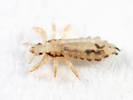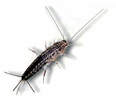
|
CENTIPEDES
 |
Contrary
to common knowledge, centipedes are actually beneficial
creatures because they feed on other pests. The
house centipede rarely bites and when it does, its
bite is no worse than a bee sting. The bite of a
giant centipede, however, can cause severe pain
and swelling. Centipedes sometimes scratch the skin
when they crawl over our body, and they also inject
venom into the scratch wound, causing swelling and
infection. |
Long,
narrow and flattened, the body of a centipede has many
segments, each bearing a pair of legs. Just behind the
head are a pair of venomous claws. The two common species
are:
House Centipede
This is greyish with long legs marked by alternate white
and dark bands. Three dark stripes run along the body
from front to back. They are 5 - 8 cm long when fully
grown.
Giant Centipede
These can grow up to 20 cm long and are really fearful.
The legs are relatively shorter than the house centipede.
Centipedes are found in dark, damp places, under leaves,
rotten logs, stones and cardboard boxes. They are active
at night and feed on ants, cockroaches, flies, earthworms
and other small animals. Indoors, the house centipedes
are found in damp basements and bathrooms. When disturbed,
they crawl quickly in search of hiding places.
CONTROL
1. As far as possible, clear out
damp and dark places inside the house.
2. Outdoors, piles of unwanted items, leaves and piles
of grass should be removed.
3. An insecticide with a long-lasting effect can be applied
in cracks and crevices, basements, around doors, windows
and other entry points.
________________________________________
HEAD LICE
 |
Head
lice cause irritation and itching to the scalp by
piercing the skin and injecting toxins. This leads
to weariness and tiredness in a person. Scratching
the head can cause infection of the bite wounds
by fungi and bacteria. If left untreated, the eggs
of head lice remain in the hair for a long time.
|
Each
female lays approximately 300 eggs which are cemented
to the hair. The cement cannot be removed without damaging
the hair or scalp. It takes just 5 - 10 days for the eggs
to hatch. Head lice infest the hair of the head, while
sucking blood from the hosts. Lice are usually spread
through the use of communal combs and brushes, personal
contact with the infested individual or contact with infested
bedclothes and clothing. Head louse is common in over-crowded
places and among people with poor personal hygiene.
CONTROL
1. Avoid contact with infested
persons.
2. Infested people should wash their hair and head often
and thoroughly with hot water.
3. Hair combs and brushes and bedclothes must be isolated
from others.
4. See a pharmacist for a medication to remove head lice.
5. You can remove the eggs from hair with a fine-toothed
metal comb specially made for this purpose.
6. Call in SWAT Pest Control
for a thorough job.
________________________________________
MILLIPEDES
 |
Millipedes
do not bite or sting humans. They are usually found
in the garden and in decaying vegetation. Some millipedes
secrete a liquid that leaves a stain and causes
severe skin inflamation and blindness in humans.
|
Millipedes
normally live outdoors where they feed on damp and decaying
wood and vegetation. Sometimes they leave the soil and
can be found crawling in the house, or hiding beneath
flower pots. The migration into the house may be due to
heavy rain which raises the water level in the soil and
forces them to seek shelter elsewhere.
When threatened or in danger, they roll up into a ball.
Some species secrete a repugnant liquid which is brown
or white. The liquid is toxic to other small animals and
is usually exuded slowly, although sometimes it can discharge
the liquid as a spray.
CONTROL
1. As millipedes thrive in damp
organic matter, remove all decaying vegetation regularly.
2. Check also for wood buried in the soil.
3. Millipedes are killed by insecticide sprays or dusts.
4. Special attention should be given to all millipede
entry points.
5. A pest control operator is needed to treat the premises
and surrounding areas. Call SWAT Pest Control for
a thorough job.
________________________________________
SILVERFISH
 |
Silverfish
cause damage by eating into books, book bindings,
photographs, and cause wallpaper to flake off by
feeding on the paste. They are wingless insects
with flattened, slender bodies. The body is carrot-shaped
and tapers gradually to the back, giving it a fish-like
appearance. |
Silverfish
are nocturnal insects that normally stay away from sunlight.
They can be found anywhere in the house where it's dark
and undisturbed, such as basements and book shelves. They
feed actively at night on human food, starch, glue, paper,
paste, silk or linen.
CONTROL
Thorough inspections are necessary
to find their hiding places. Use of a flushing aerosol
helps to locate them.
1. Seal up all cracks and crevices where silverfish can
hide and breed.
2. To avoid infestation, inspect all books, particularly
old books that you bring into the house.
3. Where possible, store book, files and papers in airy
places.
4. Human food should be kept in tight containers and food
crumbs cleaned and removed to deprive the pest of food
sources.
5. To safeguard your valuable books and documents, get
reliable service from SWAT
Pest Control. .
|